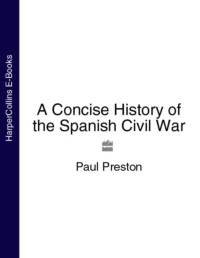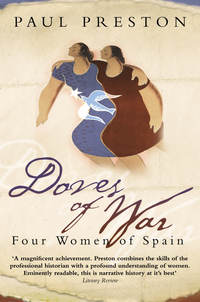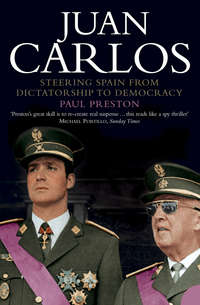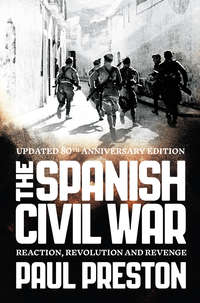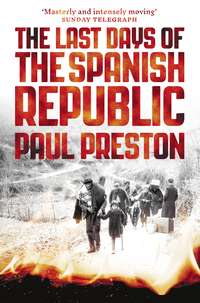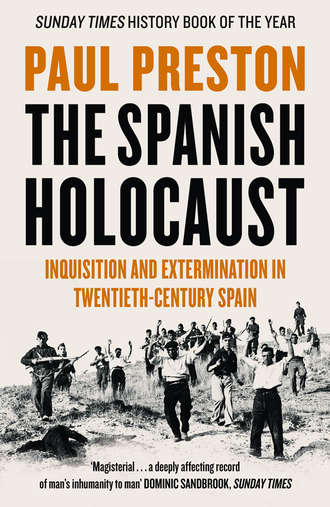
Полная версия
The Spanish Holocaust: Inquisition and Extermination in Twentieth-Century Spain
Endorsement of The Protocols also came from the founder of the ultra-right-wing monarchist theoretical journal Acción Española, the Marqués de Quintanar. At an event held in his honour at the Ritz, Quintanar alleged that the disaster of the fall of the monarchy came about because ‘The great worldwide Jewish–Masonic conspiracy injected the autocratic Monarchies with the virus of democracy to defeat them, after turning them into liberal Monarchies.’14 Julián Cortés Cavanillas, also of the Acción Española pressure group, cited The Protocols as proof that through Masonic intermediaries the ‘evil offspring of Israel’, the Jews, controlled the anarchist, Socialist and Communist hordes. That the new Republican–Socialist government contained Freemasons, Socialists and men thought to be Jewish was proof positive that the alliance of Marx and Rothschild had established a bridgehead in Spain.15 Reviewing with total seriousness a French edition of The Protocols as if it were empirical truth, the Marqués de Eliseda implied with a veiled reference to Margarita Nelken that Castilblanco had been masterminded by the Jews.16
Other influential writers in Acción Española were the lay theologian Marcial Solana and Father Aniceto de Castro Albarrán, the senior canon of Salamanca Cathedral. They, and Father Pablo Leon Murciego, produced theological justifications for the violent overthrow of the Republic. They argued that it was a Catholic duty to resist tyranny. Solana used St Aquinas to justify the assertion that the tyrant was any oppressive or unjust government. Since power ultimately rested with God, an anti-clerical constitution clearly rendered the Republic tyrannical.17 In 1932, Castro Albarrán, at the time rector of the Jesuit University of Comillas, had written a book on the right to rebellion. Although it was not published until 1934, an extract was presented in Acción Española which reinforced Solana’s incitements to rebellion and specifically attacked the legalism of El Debate. Castro Albarrán, through his articles and sermons, would become the principal theological apologist of the military rising. He later summed up his views in his 1938 book Guerra santa (Holy War).18 He, Solana and others argued that violence against the Republic was justified because it was a holy rebellion against tyranny, anarchy and Moscow-inspired Godlessness. In 1932, Father Antonio de Pildain Zapiain, deputy for Guipúzcoa and canon of Vitoria Cathedral, declared in the Cortes that Catholic doctrine permitted armed resistance to unjust laws. Similar arguments were central to a controversial book published in 1933 by Father José Cirera y Prat.19
The writings of Castro Albarrán and Cirera horrified more moderate clerics such as Cardinal Eustaquio Ilundain Esteban of Seville and Cardinal Vidal i Barraquer of Tarragona. Vidal was distressed by the arrogance with which Castro Albarrán presented as Catholic doctrine partisan ideas which ran counter to Vatican policy on coexistence with the Republic. He protested to Cardinal Pacelli, the Papal Secretary of State, who ordered that the nihil obstat (seal of ecclesiastical approval) be removed from the book and tried to have it withdrawn from circulation. The book was serialized in the Carlist press, and the newly appointed Primate of All Spain, Archbishop Isidro Gomá of Toledo, expressed his approval to members of Acción Española.20 Gomá’s predecessor in Toledo, Cardinal Pedro Segura y Sáenz, exiled in Rome, was presented by the Carlist newspaper El Siglo Futuro as the archetype of Catholic intransigence to the Republic. He would later be found actively encouraging the Carlist leadership as their armed militia or Requetés trained for insurrection against the Republic.21
General Franco was a subscriber to Acción Española and a firm believer in the Jewish–Masonic–Bolshevik contubernio (filthy concubinage). Significantly, among the many other senior military figures sharing such views was General Emilio Mola, the future director of the military coup of 1936. The tall, bespectacled Mola had the air of a monkish scholar, but his background was that of no-nonsense veteran of the African wars. Born in Cuba in 1887, the son of a captain of the Civil Guard, a harsh disciplinarian, he rose to military prominence serving with the Regulares Indígenas (Native Regulars – locally recruited mercenaries) during the African wars. His memoirs of Morocco, wallowing in descriptions of crushed skulls and bloated intestines, suggest that he had been utterly brutalized by his African experiences.22 In February 1930 in the wake of the fall of the dictatorship, Mola was appointed Director General of Security. He quickly took to police work. Until the collapse of the monarchy fourteen months later, he devoted himself to crushing labour and student subversion as he had crushed tribal rebellion in Morocco.23 To this end, he created a crack anti-riot squad, physically well trained and well armed, and a complex espionage system. This so-called Sección de Investigación Comunista used undercover policemen to infiltrate opposition groups and then act as agents provocateurs. The network was still substantially in place in 1936 when Mola employed it in the preparation of the military uprising.24
Mola over-estimated the menace of the minuscule Spanish Communist Party, which he viewed as the tool of sinister Jewish–Masonic machinations. This reflected the credence that he gave to the fevered reports of his agents, in particular those of Santiago Martín Báguenas and of the sleazy and obsessive Julián Mauricio Carlavilla del Barrio. Mola’s views on Jews, Communists and Freemasons were also coloured by information received from the organization of the White Russian forces in exile, the Russkii Obshche-Voinskii Soiuz (ROVS, Russian All-Military Union) based in Paris. Thereafter, even when he was no longer Director General of Security, he remained in close contact with the ROVS leader Lieutenant General Evgenii Karlovitch Miller. Miller was, like the Nazi racial theorist Alfred Rosenberg, a Baltic German. Their hatred of communism reflected the fact that the Bolshevik revolution saw them lose their families, property, livelihood and homeland. Believing that the Jews had masterminded the revolution, they were determined to prevent them doing the same in western Europe.25
When the Republic was established, convinced that he would be arrested for his work in defence of the monarchy, Mola went into hiding. Then on 21 April 1931, he gave himself up to the Minister of War, Manuel Azaña. Four days earlier, General Dámaso Berenguer had been arrested for his role in the Moroccan wars, as Prime Minister and later as Minister of War during the summary trial and execution of the two pro-Republican rebels Captains Fermín Galán and Ángel García Hernández. The arrests of Mola and Berenguer fed the right-wing perception of the Republic as vindictive.26 In the eyes of the Africanistas, Berenguer was being persecuted for his part in a war in which they had risked their lives, and for following military regulations in court-martialling the mutineers Galán and García Hernández. Similarly, they saw Mola as a hero of the African war who, as Director General of Security, had merely been doing his job of controlling subversion. The Africanistas were enraged that officers whom they admired were persecuted while those who had plotted against the Dictator were rewarded. The arrests gave Africanistas like Manuel Goded, Joaquín Fanjul, Mola and Franco a justification for their instinctive hostility to the Republic. They regarded the officers who received the preferment of the Republic as the lackeys of Jews and Freemasons, weaklings who pandered to the mob.
Awaiting trial for his use of excessive force against a student demonstration on 25 March, Mola was imprisoned in a ‘damp and foul-smelling cell’ in a military jail.27 Azaña arranged on 5 August for this to be changed to house arrest, but, unsurprisingly, seeing his recent targets now in positions of power, Mola nurtured a rancorous hostility to the Republic and a personal hatred of Azaña. The paranoid reports sent him by Carlavilla and the dossiers supplied by the ROVS convinced him that the triumph of the democratic regime had been engineered by Jews and Freemasons. In late 1931, in the first volume of his memoirs, he wrote of the threat of Freemasonry: ‘When, in fulfilling my duties, I investigated the intervention of the Masonic lodges in the political life of Spain, I became aware of the enormous strength at their disposal, not through the lodges themselves but because of the powerful elements that manipulated them from abroad – the Jews.’ Acción Española celebrated the appearance of the book with a rapturous nine-page review by Eugenio Vegas Latapié, one of the journal’s founders and a fierce advocate of violence against the Republic.28
By the time that Mola came to write the second volume of his memoirs, he was more explicit in his attacks on Freemasons and Jews. He himself implied that this was because, in addition to the reports of General Miller, he had read both the work of Father Tusquets and The Protocols of the Elders of Zion. Thus Mola wrote that the coming of the Republic was a reflection of the hatred for Spain of the Jews and Freemasonry:
What rational motives exist to explain why we Spaniards excite the hatred of the descendants of Israel? Fundamentally three: the envy produced in them by any race that has a fatherland of its own; our religion for which they feel unquenchable revulsion because they blame it for their dispersion throughout the world; the memory of their expulsion, which came about not, as is often claimed, because of a King’s whim but because the people demanded it. These are the three points of the Masonic triangle of the Spanish lodges.29
In December 1933, Mola wrote the conclusion to his bitterly polemical book El pasado, Azaña y el porvenir (The Past, Azaña and the Future), in which he gave voice to the widespread military animosity towards the Republic in general and towards Azaña in particular. Mortified by what he perceived as the unpatriotic anti-militarism of the left, he attributed it to various causes, mainly to the fact that:
decadent nations are the favourite victims of parasitical international organizations, used in their turn by the Great Powers, taking advantage of the situation in weak nations, which is where such organizations have most success, just as unhealthy organisms are the most fertile breeding ground of the virulent spread of pathological germs. It is significant that all such organizations are manipulated if not actually directed by the Jews … The Jews don’t care about the destruction of a nation, or of ten, or of the entire world, because they, having the exceptional ability to derive benefit from the greatest catastrophes, are merely completing their programme. What has happened in Russia is a relevant example and one that is very much on Hitler’s mind. The German Chancellor – a fanatical nationalist – is convinced that his people cannot rise again as long as the Jews and the parasitical organizations that they control or influence remain embedded in the nation. That is why he persecutes them without quarter.30
Morose and shy, Mola was not previously noted for his popularity. With this best-seller, he found himself an object of admiration among the most reactionary military and civilian elements.31
Since 1927, both Mola and Franco had been avid readers of an anti-Communist journal from Geneva, the Bulletin de l’Entente Internationale contre la Troisième Internationale. While he was Director General of Security, Mola’s agents concocted inflated reports about the alleged threat from the Comintern, as the Third International was known. Mola passed these dubious reports to the Entente in Geneva where they were incorporated into the bulletin and sent back to Spain to Franco and other military subscribers as hard fact. The Entente had been founded by the Swiss rightist Théodore Aubert and a White Russian émigré, Georges Lodygensky. Its publications were given a vehemently anti-Semitic and anti-Bolshevik turn by Lodygensky and praised the achievements of fascism and military dictatorships as bulwarks against communism. Enjoying close contacts with Antikomintern, an organization run from Josef Goebbels’s Ministry of Information, the Entente skilfully targeted influential people and supplied them with reports which purported to expose plans for forthcoming Communist offensives. The material from the Entente devoured by Franco, Mola and other officers portrayed the Second Republic as a Trojan horse for Communists and Freemasons determined to unleash the Godless hordes of Moscow against Spain and all its great traditions.32 For the Spanish extreme right and for many of their allies abroad, the Second Republic was an outpost of the Elders of Zion.33
One of the most prominent leaders of the Spanish fascist movement, Onésimo Redondo Ortega, was a fervent believer in The Protocols. Redondo had studied in Germany and was also close to the Jesuits. He was much influenced by Father Enrique Herrera Oria, brother of the editor of El Debate, Ángel Herrera Oria. Father Herrera had encouraged Onésimo in the belief that communism, Freemasonry and Judaism were conspiring to destroy religion and the fatherland and recommended that he read the virulent anti-Jewish and anti-Masonic tract by Léon Poncins, Las fuerzas secretas de la Revolución. F




The ultra-right-wing press in general regarded The Protocols as a serious sociological study. Since there were few Jews in Spain, there was hardly a ‘Jewish problem’. However, Spanish ‘anti-Semitism without Jews’ was not about real Jews but was an abstract construction of a perceived international threat. Anti-Semitism was central to integrist Catholicism and harked back to Judas Iscariot’s betrayal of Jesus Christ and to medieval myths and fears about Jewish ritual killings of children. Now, it was given a burning contemporary relevance by fears of revolution. The notion that all those belonging to left-wing parties were the stooges of the Jews was supported by references to the left-wingers and Jews fleeing from Nazism who found refuge in the Second Republic. As far as the Carlist press was concerned, the few incoming Jews were the advance guard of world revolution and intended to poison Spanish society with pornography and prostitution.35 Opposed to urbanism and industrialism, to liberalism and capitalism, all ideologies associated with Jews and Freemasons, the Carlists aspired to destroy the Republic by armed insurrection and to impose a kind of rural Arcadian theocracy.36
Conservative intellectuals argued that through various subversive devices the Jews had enslaved the Spanish working class. One alleged consequence of this subjugation was that the Spanish workers themselves came to possess oriental qualities. The Spanish radical right began to see the working class as imbued with Jewish and Muslim treachery and barbarism. The most extreme proponent of this view was the late nineteenth-century Carlist ideologue Juan Vázquez de Mella. He argued that Jewish capital had financed the liberal revolutions and was now behind the Communist revolution in order, in union with the Muslim hordes, to destroy Christian civilization and impose Jewish tyranny on the world. Even King Alfonso XIII believed that the rebellion of tribesmen in the Rif was ‘the beginning of a general uprising of the entire Muslim world instigated by Moscow and international Jewry’.37 Carlist ideologues took these ideas seriously, arguing that ‘the four horsemen of the Apocalypse, Judaism, Communism, Freemasonry and Death’, already controlled Britain, France and Australia and soon Spain would fall under their dominion.38
The books of Vázquez de Mella and other Carlist ideologues were eagerly devoured by Colonel José Enrique Varela during his imprisonment after the Sanjurjada. Contrasting the success of the Primo de Rivera coup of 1923 and the failure of Sanjurjo in 1932, the dynamic and courageous Varela was convinced that a successful military rising needed substantial civilian support. He was persuaded that this could be found in the fierce Carlist militia, the Requeté. Although he resisted calls to lead an exclusively Carlist uprising on the grounds that this required someone more senior such as Franco, Varela undertook to turn the Requeté into an effective citizen army. Since he was still under police surveillance, on his trips to the Carlists’ northern heartland of Navarre he took the pseudonym ‘Don Pepe’. Day-to-day training was supervised by the National Inspector of the Requeté, the retired Lieutenant Colonel Ricardo de Rada, who also would train the Falangist militia.39 Similarly, in 1934 another of the officers involved in the Sanjurjada, the Civil Guard Captain Lisardo Doval, would train the paramilitary squads of the Juventud de Acción Popular (the youth movement of Gil Robles’s Catholic party, the CEDA).
Carlists, theologians and Africanista officers were among those who through their writings and speeches fomented an atmosphere of social and racial hatred. Another was Onésimo Redondo. Although hardly a national figure, he merits attention both as one of the founders of Spanish fascism and because it was largely due to his ideas that his home town, Valladolid, experienced greater political violence than other Castilian provincial capitals. As a young lawyer, Onésimo Redondo had been involved in Acción Nacional (as Acción Popular was originally called), the Catholic political group founded on 26 April 1931 by Ángel Herrera Oria and principally supported by Castilian farmers. In early May, he set up its local branch in Valladolid and headed its propaganda campaign for the forthcoming parliamentary elections. On 13 June, Onésimo launched the first number of the fortnightly, and later weekly, anti-Republican newspaper Libertad. After the Republican–Socialist coalition won a huge majority on 28 June, Onésimo rejected democracy, broke with Acción Nacional and, in August, founded a fascist party, the Juntas Castellanas de Actuación Hispánica (the Castilian Hispanic Action Groups).40
On 10 August, he published a fiery proclamation in Libertad expressing his commitment to the traditional rural values of Old Castile, to social justice and to violence. He wrote: ‘The historic moment, my young countrymen, obliges us to take up weapons. May we know how to use them to defend what is ours and not to serve politicians.’ For him ‘nationalism is a movement of struggle, it must include warlike, violent activities in the service of Spain against the traitors within’.41 Certainly, Onésimo Redondo and the Juntas brought a tone of brutal confrontation to a city previously notable for the tranquillity of its labour relations.42 Onésimo called for ‘a few hundred young warriors in each province, disciplined idealists, to smash to smithereens this dirty phantom of the red menace’. His recruits armed themselves for street fights with the predominantly Socialist working class of Valladolid. He wrote of the need to ‘cultivate the spirit of violence, of military conflict’. The meetings of the Juntas were held in virtual clandestinity. Over the next few years, his enthusiasm for violence grew progressively more strident.43
The numerical weakness of the Juntas obliged Onésimo to seek links with like-minded groups. Accordingly, his gaze fell upon the first overtly fascist group in Spain, the tiny La Conquista del Estado (the Conquest of the State) led by Ramiro Ledesma Ramos.44 Originally from Zamora, Ledesma worked in a post office in Madrid. An enthusiastic disciple of German philosophy, he had founded his group in February 1931 in a squalid room in a Madrid office block. The light had not been connected and the only furniture was a table. The ten participants signed a manifesto he had written entitled ‘The Conquest of the State’. A newspaper of the same name was launched on 14 March. Despite public indifference and police harassment, it survived for a year.45 In the first number of Libertad, Onésimo Redondo had referred favourably to Ledesma Ramos’s newspaper: ‘We approve of the combative ardour and the eagerness of La Conquista del Estado, but we miss the anti-Semitic activity which that movement needs be effective and to go in the right direction.’46 Although Redondo translated Hitler’s Mein Kampf, his anti-Semitism drew more on the fifteenth-century Castilian Queen Isabel la Católica than on Nazism. Anti-Semitism was a recurring theme in his writings. In late 1931, for instance, he described the co-educational schools introduced by the Second Republic as an example of ‘Jewish action against free nations: a crime against the health of the people for which the traitors responsible must pay with their heads’.47
In October 1931, Onésimo met Ledesma Ramos in Madrid. Over the next few weeks, in several meetings in Madrid and Valladolid, they negotiated the loose fusion of their two groups as the Juntas de Ofensiva Nacional Sindicalista (the Groups of National Syndicalist Offensive or JONS). Launched on 30 November 1931, the JONS adopted the red and black colours of the anarcho-syndicalist CNT and took as its badge the emblem of the Catholic kings, the yoke and arrows. It was anti-democratic and imperialist, demanding Gibraltar, Morocco and Algeria for Spain and aspiring to ‘the extermination, the dissolution of the antinational, Marxist parties’. To this end, ‘national-syndicalist militias’ were to be created ‘in order to oppose red violence with nationalist violence’. Ledesma Ramos argued that political violence was legitimate and advocated the creation of armed militias along the lines of the Italian Fascist Squadri to prepare for insurrection or coup d’état.48 By way of practice, the JONS squads assaulted left-wing students and, in June 1933, sacked the Madrid offices of the Association of Friends of the USSR.49
In Valladolid, Onésimo devoted ever more time to the conversion of his forty-odd followers into warriors of what he now called ‘organized anti-communist militias’. Soon they would be involved in bloody clashes with left-wing students and workers in the University and in the streets of Valladolid. Pistols were being bought and much time was spent on training. Already by the spring of 1932, Onésimo Redondo was writing about the civil war to come – ‘The war is getting nearer; the situation of violence is inevitable. There is no point in rejecting it. It is stupid to flee from making war when they are going to make war on us. The important thing is to prepare to win, and, to win, it is necessary to seize the initiative and go on to the attack.’ On 3 May 1932, a pitched battle was fought with the left in the main square of Valladolid after which more than twenty people were hospitalized. Onésimo himself was sentenced to two months in prison for the excesses of Libertad.50
Imprisonment did nothing to mellow Onésimo Redondo. His article in the fascist monthly JONS in May 1933 reflected the growing virulence of his thought and echoed Sanjurjo’s identification of the Spanish working class with the Arabs:
Marxism, with its Mohammedan utopias, with the truth of its dictatorial iron and with the pitiless lust of its sadistic magnates, suddenly renews the eclipse of Culture and freedoms like a modern Saracen invasion … This certain danger, of Africanization in the name of Progress, is clearly visible in Spain. We can state categorically that our Marxists are the most African of all Europe … Historically, we are a friction zone between that which is civilized and that which is African, between the Aryan and the Semitic … For this reason, the generations that built the fatherland, those that freed us from being an eternal extension of the Dark Continent, raised their swords against attacks from the south and they never sheathed them … The great Isabel ordered Spaniards always to watch Africa, to defeat Africa and never be invaded by her again. Was the Peninsula entirely de-Africanized? Is there not a danger of a new kind of African domination, here where so many roots of the Moorish spirit remained in the character of a race in the vanguard of Europe? We ask this important question dispassionately and we will answer it right away by underlining the evident danger of the new Africanization: ‘Marxism’. Throughout the world, there exists the Jewish or Semite conspiracy against Western civilization, but in Spain it can more subtly and rapidly connect the Semitic element, the African element. It can be seen flowering in all its primitive freshness in our southern provinces, where Moorish blood lives on in the subsoil of the race … The follower of Spanish Marxism, especially the Andalusian, soon takes the incendiary torch, breaks into manor houses and farms, impelled by the bandit subconscious, encouraged by the Semites of Madrid; he wants bread without earning it, he wants to laze around and be rich, to take his pleasures and to take his revenge … and the definitive victory of Marxism will be the re-Africanization of Spain, the victory of the combined Semitic elements – Jews and Moors, aristocrats and plebeians who have survived ethnically and spiritually in the Peninsula and in Europe.51


